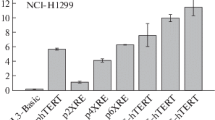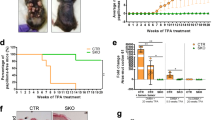Abstract
Nodularin is a new liver carcinogen possessing a potent tumor-promoting activity in rat liver, mediated through inhibition of protein phosphatases 1 and 2A, and a weak initiating activity. Since we previously reported evidence that nodularin up-regulated expression of the tumor necrosis factor α gene (TNFα) and early-response genes in rat liver after its i.p. administration, and since TNFα had tumor-promoting activity in vitro, it is possible that TNFα itself is involved in liver tumor promotion. We investigated whether hepatocytes themselves induce expression of theTNFα gene and early-response genes in primary cultured rat hepatocytes treated with nodularin. Like nodularin, microcystin-LR, which is another liver tumor promoter belonging to the okadaic acid class, strongly inducedTNFα gene expression in rat hepatocytes, as well as TNFα release from those cells into the medium. On the other hand, 12-O-tetradecanoylphorbol-13-acetate, which has been reported to induce no tumor promotion in rat liver, induced no apparent expression of theTNFα gene in primary cultured rat hepatocytes. As for the expression of early-response genes, 1 μM nodularin or microcystin-LR induced expression of the c-jun, jun B,jun D, c-fos, fos B andfra-1 genes in the hepatocytes, and the expression of these genes was prolonged up to 24 h, suggesting mRNA stabilization induced by inhibition of protein phosphatases 1 and 2A. This paper presents new evidence that theTNFα gene and early-response genes were expressed in hepatocytes treated with a liver tumor promoter.
Similar content being viewed by others
Abbreviations
- GST-P :
-
glutathioneS-transferase placental form
- TNFα:
-
tumor necrosis factor α
- GAPDH :
-
glyceraldehyde-3-phosphate dehydrogenase
- SSC :
-
standard saline citrate
- SDS :
-
sodium dodecyl sulfate
- TPA :
-
12-O-tetradecanoylphorbol-13-acetate
References
Annila A, Lehtimaki J, Mattila K, Eriksson JE, Sivonen K, Rantala TT, Drakenberg T (1996) Solution structure of nodularin an inhibitor of serine/threonine-specific protein phosphatases. J Biol Chem 28:16 695–16 702
Carmichael WW, Eschedor JT, Patterson GML, Moor RE (1988) Toxicity and partial structure of a hepatotoxic peptide produced by the cyanobacteriumNodularia spumigena mertens emend. L575 from New Zealand. Appl Environ Microbiol 54:2257–2263
Chen CYA, Shyu AB (1995) AU-rich elements: characterization and importance in mRNA degradation. Trends Biochem Sci 20:465–470
Chensue SW, Terebuh PD, Remick DG, Scales WE, Kunkel SL (1991) In vivo biologic and immunohistochemical analysis of interleukin-1 alpha, beta and tumor necrosis factor during experimental endotoxicemia. Kinetics, Kupffer cell expression, and glucocorticoid effects. Am J Pathol 138:395–402
Chomczynski P, Sacci N (1987) Single-step method of RNA isolation by acid guanidinium thiocyanate-phenol-chloroform extract. Anal Biochem 162:156–159
Fujiki H, Suganuma M (1993) Tumor promotion by inhibitors of protein phosphatases 1 and 2A: the okadaic acid class of compounds. Adv Cancer Res 61:143–194
Harada KI, Oshikata M, Uchida H, Suzuki M, Kondo F, Sato K, Ueno Y, Yu SZ, Chen G, Chen GC (1997) Detection and identification of microcystins in the drinking water of Haimen city, China. Natural Toxins (in press)
Holladay K, Fujiki H, Bowden GT (1992) Okadaic acid induces the expression of both early and secondary response genes in mouse keratinocytes. Mol Carcinog 5:16–24
Komori A, Yatsunami J, Suganuma M, Okabe S, Abe S, Sakai A, Sasaki K, Fujiki H (1993) Tumor necrosis factor acts as a tumor promoter in BALB/3T3 cell transformation. Cancer Res 53:1982–1985
Krishnamurthy T, Carmichael WW, Sarver EW (1986) Toxic peptides from freshwater cyanobacteria (blue-green algae). Isolation, purification and characterization of peptides fromMicrocystis aeruginosa andAnabaena flos-aguae. Toxicon 24:865–873
Michael LK (1990) Netpen liver disease (NLD) of salmonid fishes reared in sea water: species susceptibility, recovery, and probable cause. Dis Aquat Org 8:21–28
Nishiwaki R, Ohta T, Sueoka E, Suganuma M, Harada KI, Watanabe MF, Fujiki H (1994) Two significant aspects of microcystin-LR: specific binding and liver specificity. Cancer Lett 83:283–289
Ohta T, Nishiwaki R, Yatsunami J, Komori A, Suganuma M, Fujiki H (1992) Hyperphosphorylation of cytokeratins 8 and 18 by microcystin-LR, a new liver tumor promoter, in primary cultured rat hepatocytes. Carcinogenesis 13:2443–2447
Ohta T, Sueoka E, Iida N, Komori A, Suganuma M, Nishiwaki R, Tatematsu M, Kim SJ, Carmichael WW, Fujiki H (1994) Nodularin, a potent inhibitor of protein phosphatases 1 and 2A, is a new environmental carcinogen in male F344 rat liver. Cancer Res 54:6402–6406
Park K, Chung M, Kim SJ (1992) Inhibition of myogenesis by okadaic acid, an inhibitor of protein phosphatases 1 and 2A, correlates with the induction of AP1. J Biol Chem 267:10 810–10 815
Quinn RJ, Taylor C, Suganuma M, Fujiki H (1993) The conserved acid binding domain model of inhibitors of protein phosphatases 1 and 2A: molecular modeling aspects. Biomed Chem Lett 6:1029–1034
Rieckmann P, Thevenin G, Kehrl JH (1992) Okadaic acid is a potent inducer of AP-1, NF-kB, and tumor necrosis factor-α in human B lymphocytes, Biochem Biophys Res Commun 187:51–57
Rinehart KL, Harada KI, Namikoshi M, Chen C, Harvis CA (1988) Nodularin microcystin and the configuration of Adda. J Am Chem Soc 110:8557–8558
Rosenberger SF, Bowden GT (1996) Okadaic acid stimulated TRE binding activity in a papilloma producing mouse keratinocyte cell line involves increased AP-1 expression. Oncogene 12:2301–2308
Schönthal A, Alberts AS, Frost JA, Feramisco JR (1991a) Differential regulation ofjun family gene expression by the tumor promoter okadaic acid. New Biol 3:977–986
Schönthal A, Tsukitani Y, Feramisco JR (1991b) Transcriptional and post-transcriptional regulation of c-fos expression by the tumor promoter okadaic acid. Oncogene 6:423–430
Seglen PO (1976) Preparation of isolated rat liver cells. Methods Cell Biol 13:29–83
Shaw G, Kamen R (1986) A conserved AU sequence from the 3′ untranslated region of GM-CSF mRNA mediates selective mRNA degradation. Cell 46:659–667
Silva ED de, Williams DE, Andersen RJ, Klix H, Holmes CFB, Allen TM (1992) Motuporin, a potent protein phosphatase inhibitor isolated from the Papua New Guinea spongeTheonella swinhoei Gray. Tetrahedron Lett 33:1561–1564
Sueoka E, Suganuma M, Okabe S, Komori A, Kozu T, Uemura D, Ohta T, Fujiki H (1995) Expression of early response genes and of tumor necrosis factor-α gene by the okadaic acid class tumor promoters in relation to carcinogenesis. In: Sheuer P, Hokama Y, Yasumoto T (eds) Proceedings of International Symposium on Ciguatera and Marine Natural Products. Asian-Pacific Research Foundation. Honblue Printed Company, Honolulu, pp 183–196
Sueoka E, Sueoka N, Komori A, Okabe S, Kozu T, Suganuma M, Fujiki H (1996) Expression of early response genes by nodularin, a new liver carcinogen through inhibition of protein phosphatases 1 and 2A. In: Yasumoto T, Oshima Y (eds) Proceedings of the 7th International Conference on Toxic Phytoplankton. pp 483–486
Suganuma M, Okabe S, Sueoka E, Iida N, Komori A, Kim SJ, Fujiki H (1996) A new, process of cancer prevention mediated through inhibition of tumor necrosis factor α expression. Cancer Res 56:3711–3715
Sung SSJ, Walters JA, Fu SM (1992) Stimulation of tumor necrosis factor α production in human monocytes by inhibitors of protein phosphatase 1 and 2A. J Exp Med 176:897–901
Tachibana K, Scheuer PJ, Tsukitani Y, Kikuchi H, Van Engen D, Clardy J, Gopichnd Y, Schmitz FJ (1981) Okadaic acid, a cytotoxic polyether from two marine sponges of the genusHalichondria. J Am Chem Soc 103:2469–2471
Thévenin C, Kim SJ, Kehrl JH (1991) Inhibition of protein phosphatases by okadaic acid induces AP1 in human t cells. J Biol Chem 266:9363–9366
Xia HZ, Kannapell CC, Fu SM, Sung SSJ (1993) Differential regulation of human B-lymphocyte tumor necrosis factor-α (TNF-α) and lymphotoxin (TNF-β) production by protein phosphatase 1 and 2A inhibitor. Blood 82:2806–2812
Yoshizawa S, Matsushima R, Watanabe MF, Harada KI, Ichihara A, Carmichael WW, Fujiki H (1990) Inhibition of protein phosphatases by microcystin and nodularin associated with hepatotoxicity. J Cancer Res Clin Oncol 116:609–614
Yu SZ (1989) Drinking water and primary liver cancer. In: Tang ZY, Wu MC, Xia SS (eds) Primary liver cancer. Springer, Berlin; China Academic Publishers, Beijing, pp 30–37
Author information
Authors and Affiliations
Rights and permissions
About this article
Cite this article
Sueoka, E., Sueoka, N., Okabe, S. et al. Expression of the tumor necrosis factorα gene and early response genes by nodularin, a liver tumor promoter, in primary cultured rat hepatocytes. J Cancer Res Clin Oncol 123, 413–419 (1997). https://doi.org/10.1007/BF01372544
Received:
Accepted:
Issue Date:
DOI: https://doi.org/10.1007/BF01372544




